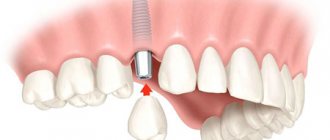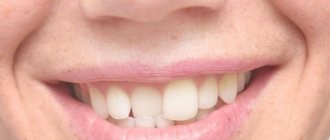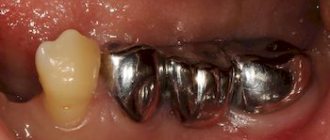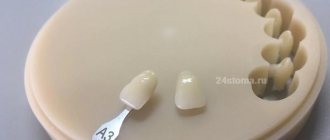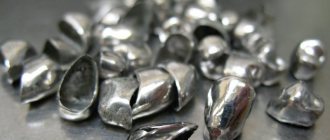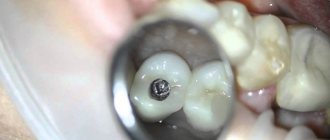Installing a crown on a tooth is one of the prosthetic options used when one or more dental units in a row are lost. Sometimes a dental crown is required even in the absence of a single edentia - for example, if it is necessary to restore the aesthetics of the dentition in the smile area. There are specific indications and contraindications for the procedure, and it is performed in several stages. We will discuss the specifics of the process of installing dental crowns in detail below.
After reading the material, you can find out how to install a crown on a tooth, what types of structures can be used in the procedure, and whether the process will be painful for the patient. We will also separately consider the specifics of removing a dental crown.
Calculate the cost of treatment by taking a short test in 20 seconds!
Do not delay your treatment, because in this matter time plays against us.
Indications for prosthetics by installing dental crowns
There are certain indications for installing a crown on a tooth, as for any other dental procedure. In what cases is prosthetics with dental crowns performed? It would be advisable to carry out the procedure in the following circumstances:
- Significant destruction of dental units by deep caries.
- Traumatic tooth destruction, in which the unit still has healthy roots.
- Aesthetic defects: noticeable discoloration of the enamel coating, chips.
Also, the installation of temporary crowns will be justified in case of periodontitis: the design will prevent further loosening of the teeth and, accordingly, will protect them from falling out. Indications for crown installation are determined during a diagnostic examination. Do you need to get a crown on your tooth? The orthopedists of our dentistry in Moscow - VENSTOM - will help you find the answer to this question! Come see a specialist at any time convenient for you. We are located next to the Baumanskaya metro station, you can walk to the clinic from the metro in just five minutes!
Does it hurt to put a crown on a tooth?
The question about the pain of installing dental crowns is the most common question among patients. And it should be noted that it is impossible to eliminate 100% discomfort during the procedure - the process of preparing for prosthetics will be most unpleasant for the patient. At this stage, the doctor will drill the teeth to gain access to the canals for their subsequent cleaning and filling.
These manipulations can be quite painful and therefore, to reduce the degree of discomfort, the specialist uses anesthetic drugs. Modern anesthetics completely remove pain, their effect lasts about 3 hours and this time is enough to complete the preparation for prosthetics. The process of installing crowns itself does not cause pain, since the structures are placed on pulpless or, more simply put, dead dental units in which there are no nerve endings.
In our dentistry in Moscow, VENSTOM, dental prosthetics with crowns are carried out using modern anesthetics, which completely eliminate unpleasant and painful sensations during treatment! You can get a detailed consultation on prosthetics by visiting our clinic. We are located next to the Baumanskaya metro station.
Dentist surgeon
One of the most difficult specializations in dentistry is surgery. Doctors perform surgical interventions during the treatment of diseases and help eliminate defects that worsen a person’s appearance. A dental surgeon performs a wide range of services:
- removes teeth;
- treats dislocations of teeth and joints;
- performs jaw surgery;
- eliminates stomatitis, pulpitis, gingivitis;
- neutralizes the infectious process;
- removes the consequences of injuries and congenital defects of the oral cavity.
Often, a prosthetist combines practice with surgical activities.
The surgeon, in tandem with the orthopedist, prepares the jaw for prosthetics, inserts and removes implants.
The main stages of the procedure for installing a dental crown
Installing a crown on a tooth - this procedure is usually divided into several stages, which will be useful to get to know before your initial visit to the dentist. The main stages of the process of placing dental crowns will be discussed in detail below.
First visit to an orthopedic dentist
During the initial appointment, the specialist examines the patient’s oral cavity, prescribing additional tests if necessary. Based on the data obtained, the doctor develops a treatment plan, offering the patient possible options for restoring lost teeth or dentition aesthetics. The treatment plan takes into account not only the need to install a denture, but also additional manipulations, including: Removal of severely damaged and non-viable dental units;
Treatment of the patient’s dental and oral diseases: caries, pulpitis, root canal filling, oral sanitation.
Next, a specific type of dental crown is selected and the cost of turnkey prosthetics is calculated and the timing of its implementation is also determined.
Is it possible to smoke if you have dentures?
There is no direct ban on smoking, but you need to understand that nicotine leads to the formation of a large amount of plaque - both on real and artificial teeth. It is difficult to remove; the gums also suffer because of it - they do not receive enough nutrients, atrophy and expose the tooth roots. If you can’t quit smoking, then try to at least reduce the number of cigarettes you consume to a minimum, at the same time improve hygiene at home, and also visit a doctor every 2-3 months for comprehensive oral hygiene.
Preparing to install dental crowns
Traditionally, crowns are placed on dead (pulpless) teeth, but sometimes there is a need to install a structure on living teeth. This has a positive effect on the final result of prosthetics, since living dental units are stronger and less susceptible to destruction processes, which ensures a long useful life of the crown. Usually, chewing teeth are not depulped during prosthetics. They have a significant area of the natural crown and the distance from the enamel layer to the pulp is greater, which eliminates burns to the natural tissues of the oral cavity during prosthetics.
List of recommended products for consumption after implantation
To ensure that the rehabilitation process does not drag on, but only has a positive effect on tissue restoration, osseointegration of the titanium pin, and strengthens the immune system, experts have determined what you can eat after installing implants:
- fermented milk products: soft cottage cheese, kefir, yoghurts;
- puree soups, broths;
- vegetable puree, pureed in a blender or softened in another way;
- omelette;
- pureed fruits without small seeds;
- all baby food;
- water at room temperature will be the best drink these days, you can use non-acidic juices without sugar, not hot weak green or herbal tea.
Free consultation on the cost of treatment in our dentistry
Leave a request and the clinic administrator will contact you within 15 minutes!
For single-rooted dental units, the depulpation process is mandatory, since the risks of thermal burns during grinding are quite high and this is fraught with the future development of an inflammatory process under the crown. Single-rooted teeth are drilled out, the nerve is removed, and the canals are cleaned and filled.
If there are dental diseases - caries, pulpitis, periodontitis - manipulations are performed to treat them. The nerves of the unit are removed, the canals are expanded with a special instrument, filled with gutta-percha, after which a filling is installed on the tooth itself. In case of serious damage to a tooth due to caries, it is important to install a strong filling and provide additional fixation. If this is not done, the dental crown may simply fall out along with a poor-quality filling. The process of restoration of a natural dental crown can be implemented in practice using two methods:
1. Installing a crown on a pin. The pin element is screwed into a pre-filled root canal and the natural coronal part of the tooth is restored at its base. After the filling is made, it is ground down to install the crown.
2. Using a stump insert. This element is manufactured in laboratory conditions and, when installed, is fixed in two areas at once: the dental canal and the area of the natural tooth crown.
These labor-intensive manipulations are carried out exclusively in the presence of serious destruction in the area of the natural dental crown, and if we compare the methods in terms of reliability, then the most high-quality result can be obtained by placing a stump inlay.
Grinding teeth for crown installation
The professional name for the process of grinding teeth for installation of crowns is preparation, which is performed with a special device - a drill. Using diamond burs, the doctor gives the dental units the shape that will allow the crown to be firmly installed. Grinding can be a rather painful procedure for the patient if dental units that are not previously depulped are subjected to treatment. In this case, local anesthesia is required.
Natural tooth tissue is removed by a specialist to the thickness that the crown will have. On average, up to 2.5 millimeters of dentin can be removed from each side of the unit, depending on the type of crown prosthesis. Cast crowns require minimal grinding of teeth; maximum layers of tissue are removed before installing ceramic and metal-ceramic products. After grinding, a stump base remains from the tooth, on which the prosthetist will subsequently install a crown.
Features of nutrition during the rehabilitation period
It is advisable that the diet after dental implantation include:
- Calcium-rich foods. These include milk, kefir, cottage cheese, sour cream, and natural yogurt. This macronutrient helps bone tissue grow faster and stabilize the implant.
- Foods high in vitamin D3 and Omega-3. These include cod liver, herring, mackerel, salmon, and sardines. These substances promote better absorption of calcium, increase immunity, and improve metabolic processes.
- Porridge, vegetables, fruits. Enrich the diet with essential vitamins and minerals.
Also, the daily menu should include meat and fish dishes. If solid food is not indicated, you should prepare minced meat dishes by steaming them so that the consistency is as tender as possible.
Taking impressions and making crowns
An impression is taken of the prepared dental units. For this procedure, a special dental plastic mass is used. An impression is necessary to make an exact plaster copy of the patient’s teeth, which will be used to create a permanent structure. For the production of crowns, different types of materials can be used - metal, metal-ceramics or ceramics. The specific type of raw material is selected based on the characteristics of the case and the wishes of the patient.
The production time for dental crowns depends on the type of material chosen. The production process of ceramic and metal-ceramic products takes the longest. If structures made from these materials are chosen for prosthetics, then temporary dental crowns made of plastic are made for the patient during the period of their manufacture. Temporary crowns will help to recreate the aesthetics of the dentition and, in addition, will protect the ground and weakened teeth from the destructive effects of external factors.
iOrtho Blog
Why do chipped teeth occur and how to get rid of them?
Ligature braces: types and application features
Types of mouth guards for bruxism and features of their use
Billie Eilish, Grammy and Invisalign
Pain during tooth extraction: why and how long does it hurt?
Molars and premolars: main differences and features
Plates for dentition correction: features and effectiveness of use
Tooth erosion: what is it and how to treat it?
Trying and installing a crown
At the stage of manufacturing crowns, a preliminary fitting is required, which will allow us to evaluate the accuracy of manufacturing structures for the patient’s teeth and the tightness of the product. If all is well, the crown manufacturing process ends, the finished prosthesis is handed over to the orthopedist and the patient is invited to the specialist’s office for preliminary temporary fixation of the structure.
Temporary fixation of the crown is an event necessary to check the quality of the crown installation. The specialist will also evaluate the tightness of the prosthesis to the ground teeth and make sure that the closure of the crown with the opposing teeth occurs correctly. When temporarily fixing dental crowns, permanent cement is not used, and this allows you to quickly remove the structure if any defects are detected during its operation.
The assessment of the quality and convenience of the crown during temporary fixation is carried out within a certain period of time, which on average is 2-4 weeks. If no defects are identified during this time period and the patient does not complain of discomfort, the crown is fixed with heavy-duty permanent cement. This completes the prosthetic process.
Calculate the cost of treatment by taking a short test in 20 seconds!
Do not delay your treatment, because in this matter time plays against us.
Removing dental crowns: indications and features of the process
Removing dental crowns is a procedure that becomes necessary if certain complications arise after installing the prosthesis. Removal of the structure may be required in situations:
1. Poor quality preparation for dental crown prosthetics. If the tooth canals are poorly cleaned and poorly sealed, then an inflammatory process may begin to actively develop in them. If such a process occurs, the crown will need to be removed and the tooth treated or removed.
2. Inaccuracies in the manufacture of a crown on a tooth, in which the installed structure will overestimate the bite and not fit tightly to the tooth.
Crowns are also removed for planned replacement. High-quality structures can last up to 10 years or more, but after that the crown will be replaced with a new orthopedic product. Crown removal may be uncomfortable for the patient, so it is usually performed using local anesthesia. To remove the structure, it is sawed with a bur, removed, and those medical manipulations that are necessary for a particular case are performed.
We hope the material helped you learn all the important nuances of installing crowns on your teeth, and you can always get more detailed advice on prosthetics from the dentist at our Vanstom clinic in Moscow! To make an appointment, just call us!
